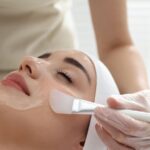
How Long for Lip Filler to Settle: Your Complete Timeline Guide
August 29, 2025
Types of Chemical Peels: Your Complete Guide to Skin Transformation
September 2, 2025When considering ways to refresh and revitalize your skin, you’ve likely wondered, “what is a chemical peel?” Chemical peels have become one of the most popular cosmetic treatments for addressing various skin concerns, from acne scars to fine lines. At Pōk Aesthetic Bar in Pointe-Claire, QC, we help clients understand exactly what chemical peels can do for their skin and why they’ve become such a sought-after treatment option.
What is a chemical peel? Simply put, it’s a cosmetic procedure that uses a chemical solution to remove damaged layers of skin, revealing smoother, more youthful skin underneath. This controlled skin injury stimulates your body’s natural healing process, promoting the growth of new, healthier skin cells. 🌟
Understanding Different Types of Chemical Peels
When exploring what is a chemical peel treatment, it’s essential to understand that not all peels are created equal. Chemical peels are categorized into three main types based on their depth of penetration and strength.
Superficial peels use mild acids like glycolic or lactic acid to gently exfoliate the outermost layer of skin. These are perfect for first-time peel users and those with sensitive skin. Medium peels penetrate deeper using trichloroacetic acid (TCA), while deep peels use phenol to reach the deepest skin layers for dramatic results.
The type of chemical peel recommended depends on your skin concerns, skin type, and desired results. Understanding what is a chemical peel’s classification helps you make informed decisions about which treatment best suits your needs.
How Chemical Peels Work on Your Skin
To truly understand what is a chemical peel’s mechanism, think of it as a controlled acceleration of your skin’s natural exfoliation process. Your skin naturally sheds dead cells every 28 days, but this process slows with age and environmental damage.
Chemical peels use specific acids to break down the bonds holding dead skin cells together. As these damaged layers peel away, your body responds by producing fresh collagen and elastin. This process reveals brighter, smoother skin with improved texture and tone.
The controlled injury aspect is key – unlike harsh scrubs or abrasive treatments, chemical peels provide precise, predictable results. Your skin receives just enough stimulation to trigger renewal without causing unnecessary trauma. ✨
Benefits of Chemical Peel Treatments
Understanding what is a chemical peel’s potential impact on your skin helps set realistic expectations. The benefits extend far beyond simple exfoliation:
Immediate improvements include brighter complexion, smoother texture, and reduced appearance of fine lines. Over time, regular chemical peel treatments can significantly improve acne scarring, hyperpigmentation, and sun damage.
For those dealing with acne-prone skin, chemical peels help unclog pores and reduce bacterial growth. The exfoliation process removes dead skin cells that can trap oil and bacteria, leading to breakouts.
Anti-aging benefits include stimulated collagen production, reduced fine lines, and improved skin elasticity. Many clients notice their skincare products absorb better after chemical peel treatments, maximizing their investment in quality skincare.
The confidence boost from clearer, more radiant skin often surprises first-time chemical peel clients. When your skin looks healthier, you feel more confident in both professional and personal settings. 💫
Chemical Peel vs. Other Skin Treatments
| Treatment Type | Downtime | Results Timeline | Best For | Cost Range |
| Chemical Peels | 3-10 days | 1-2 weeks | Texture, pigmentation, fine lines | $150-$800 |
| Microdermabrasion | None | Immediate | Light exfoliation, maintenance | $100-$300 |
| Laser Resurfacing | 1-2 weeks | 4-6 weeks | Deep wrinkles, severe scarring | $1,000-$5,000 |
| Facials | None | Immediate | Hydration, relaxation | $75-$200 |
When comparing what is a chemical peel treatment to other options, consider your specific goals, available downtime, and budget. Chemical peels offer an excellent middle-ground option for significant results without the extensive recovery time of laser treatments.
What to Expect During Your Chemical Peel
Knowing what is a chemical peel procedure like helps reduce anxiety and ensures you’re properly prepared. The process typically takes 30-60 minutes, depending on the peel type and treatment area.
Your aesthetician will first cleanse your skin thoroughly and may apply a pre-peel solution to ensure even acid penetration. The chemical solution is then applied systematically, often starting with less sensitive areas and working toward more delicate regions like around the eyes.
During application, you’ll likely experience mild tingling or warmth. This sensation is normal and indicates the peel is working effectively. Your provider will monitor your skin’s response and neutralize the acid at the appropriate time.
Post-treatment care is crucial for optimal results. Your skin may appear red immediately after treatment, similar to a mild sunburn. This reaction is expected and typically subsides within a few hours to days, depending on the peel depth.
Chemical Peel Recovery and Aftercare
Understanding what is a chemical peel recovery like helps you plan accordingly and achieve the best possible results. Recovery varies significantly based on peel depth and your individual skin response.
Days 1-3 typically involve redness and possible mild swelling. Your skin may feel tight and appear slightly darker as the damaged layers prepare to shed. Gentle cleansing and prescribed moisturizers are essential during this phase.
Days 4-7 mark the visible peeling phase. Resist the urge to pick or pull at peeling skin, as this can cause scarring or uneven results. Allow the skin to shed naturally while maintaining proper hydration.
Sun protection is absolutely critical during recovery and beyond. Your new skin is particularly vulnerable to UV damage, making broad-spectrum sunscreen non-negotiable. Most providers recommend SPF 30 or higher for at least four weeks post-treatment. ☀️
Common Chemical Peel Myths Debunked
Many misconceptions surround what is a chemical peel treatment, often preventing people from exploring this beneficial option. Let’s address the most common myths:
Myth: Chemical peels are only for mature skin. Reality: Chemical peels benefit various age groups and skin concerns. Young adults often use them for acne management, while mature clients target anti-aging concerns.
Myth: All chemical peels cause dramatic peeling. Truth: Superficial peels may cause minimal visible peeling, while deeper peels create more noticeable shedding. Your provider can adjust treatment intensity based on your comfort level and lifestyle.
Myth: Chemical peels thin your skin permanently. Fact: Properly performed chemical peels actually thicken the dermis over time by stimulating collagen production. The temporary removal of damaged surface layers reveals healthier, more resilient skin underneath.
Myth: You can’t wear makeup after chemical peels. Reality: Depending on the peel depth, makeup can often be applied within 24-48 hours using gentle, mineral-based products.
Who Should Consider Chemical Peels
Determining if you’re a good candidate involves understanding what is a chemical peel’s suitability for different skin types and concerns. Most people can benefit from some form of chemical peel treatment.
Ideal candidates include those with sun damage, acne scarring, uneven skin tone, fine lines, or rough texture. Chemical peels work well on various skin types, though darker skin tones require specialized expertise to prevent complications.
Pre-existing conditions that may affect suitability include active infections, open wounds, or certain medications that increase photosensitivity. Pregnant and nursing women typically postpone chemical peel treatments as a precautionary measure.
Your lifestyle factors also influence candidacy. If you can’t commit to strict sun protection or have upcoming events requiring perfect skin, timing becomes crucial. Most providers recommend scheduling treatments when you can dedicate proper attention to aftercare. 🎯
Cost Considerations and Treatment Frequency
Understanding what is a chemical peel investment involves more than just the initial treatment cost. Consider the long-term value and maintenance requirements.
Treatment frequency varies by peel type and individual goals. Superficial peels may be repeated monthly, while medium peels are typically spaced 3-6 months apart. Deep peels are usually one-time treatments with dramatic, long-lasting results.
Value factors include improved confidence, reduced need for heavy makeup coverage, and enhanced effectiveness of your skincare products. Many clients find chemical peels more cost-effective than constantly purchasing new serums and creams that don’t deliver similar results.
Package deals often provide better value for clients planning multiple treatments. Many practices offer loyalty programs or seasonal promotions that make regular chemical peel treatments more affordable.
Preparing for Your First Chemical Peel
Proper preparation ensures optimal results and minimizes potential complications. Understanding what is a chemical peel preparation process helps you start your journey confidently.
Two weeks before treatment, discontinue retinoids and other strong actives unless directed otherwise. Begin using gentle, fragrance-free products to minimize skin sensitivity.
Avoid sun exposure for at least one week prior to treatment. If you have a tan or recent sunburn, reschedule your appointment to prevent complications and ensure even results.
Communicate openly with your provider about medications, skincare products, and any concerns. This information helps customize your treatment for the safest, most effective experience.
Conclusion
Understanding what is a chemical peel empowers you to make informed decisions about your skincare journey. These treatments offer proven results for various skin concerns, from acne to aging, with options suitable for different lifestyles and budgets. Chemical peels provide controlled, predictable skin rejuvenation that reveals your skin’s natural radiance.
Whether you’re dealing with sun damage, acne scarring, or simply want to refresh your complexion, chemical peel treatments can help you achieve your aesthetic goals. The key lies in choosing the right type of peel and working with experienced professionals who understand your unique skin needs.
Ready to discover how what is a chemical peel can transform your skin? Schedule your consultation with Pōk Aesthetic Bar at 4649 Ponce de Leon Blvd, Suite 406, Coral Gables, FL 33146, and take the first step toward achieving the radiant, healthy skin you deserve. 🌺
Frequently Asked Questions
Q: How long does a chemical peel take to show results?
A: Most people see initial improvements within 7-10 days after treatment, with continued enhancement over 4-6 weeks as new skin cells develop and collagen production increases.
Q: Can I get a chemical peel if I have sensitive skin?
A: Yes, superficial chemical peels using gentle acids like lactic acid are specifically designed for sensitive skin types. Your provider can customize treatment strength based on your skin’s tolerance.
Q: What is the best time of year to get a chemical peel?
A: Fall and winter are ideal since sun exposure should be limited during recovery. However, chemical peels can be performed year-round with proper sun protection measures.
Q: How often should I get chemical peel treatments?
A: Frequency depends on peel type and skin goals. Superficial peels can be repeated monthly, while medium peels are typically spaced 3-6 months apart for optimal results.
Q: Can chemical peels help with acne scars?
A: Yes, chemical peels are highly effective for treating acne scarring. Medium-depth peels provide the best results for deeper scarring, while superficial peels help with mild textural issues.
People Also Ask
What’s the difference between a light and deep chemical peel? Light peels use mild acids to exfoliate surface skin with minimal downtime, while deep peels penetrate multiple skin layers for dramatic results but require extended recovery time.
Are chemical peels safe for all skin colors? Chemical peels can be safely performed on all skin tones when administered by experienced professionals using appropriate techniques and acid concentrations for darker skin.
How much does a professional chemical peel cost? Professional chemical peel costs range from $150-$800 depending on peel depth, geographic location, and provider expertise, with superficial peels being most affordable.
What should I avoid after getting a chemical peel? Avoid sun exposure, picking at peeling skin, harsh skincare products, excessive heat, and strenuous exercise for the first week after treatment to ensure optimal healing.
Can I wear sunscreen immediately after a chemical peel? Yes, gentle mineral sunscreen should be applied starting the day after treatment to protect newly revealed skin from UV damage during the healing process.

